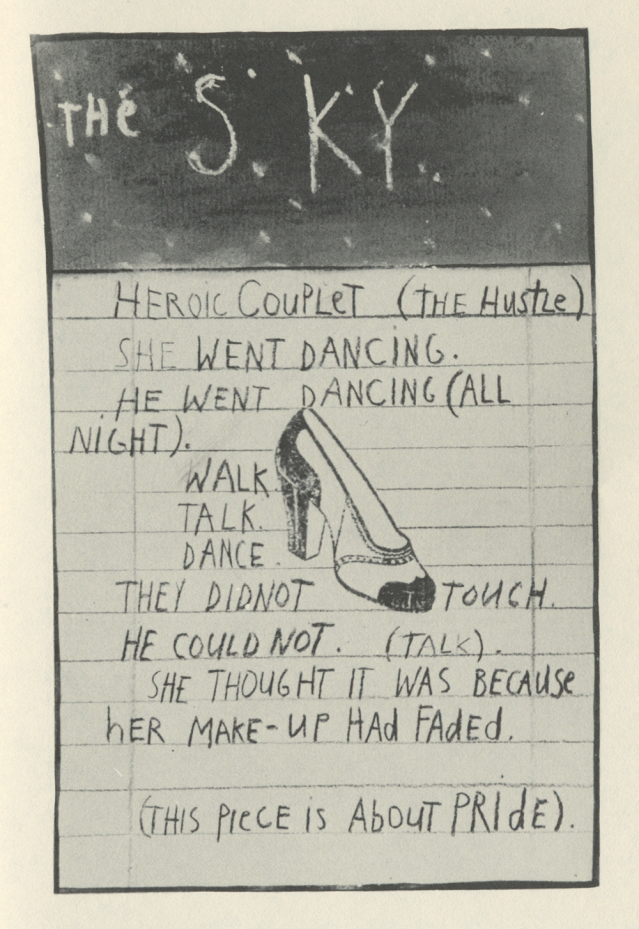
Drawing by Stephanie Brody Lederman, from Heroic Couplet (The Hustle), a portfolio that appeared in The Paris Review issue no. 75 (Spring 1979).
The Canadian writer Sam Shelstad’s third book, The Cobra and the Key, is a funny and charming satire of writing advice and the people who give it. The book is in the form of a writing manual, and its prologue begins:
Imagine you are standing in a gymnasium with numerous wooden chests spread out across the floor. Each chest contains one of two things: either a cobra, or a story. As much as you do not want to interact with the dangerous snakes, your curiosity is too great. It’s human nature to crave stories. We need them. So you gamble and open up one chest. It’s a story. You sit down and read, relieved to have avoided an encounter with one of the cobras and grateful that you get to enjoy a story. Once finished, however, you find yourself feeling anxious. The story was fine, but nothing special. You need to open another chest in the hopes of finding another, better story. In fact, you will not be satisfied until all non-snake chests have been opened and you have recovered every possible story. And so, inevitably, you open a cobra chest. You are bitten and the poison slowly kills you.
Straight-faced, grandiose, slightly lunatic—this man is our guide. A hundred and fifty-three short chapters follow, covering such topics as “Getting Started,” “Plot,” “Style,” “Point of View,” “Revision,” and so on.
I think what confuses me so much about those who have prescriptions for how to write is that they assume all humans experience the world the same way. For instance, that we all think “conflict” is the most interesting and gripping part of life, and so we should all make conflict the heart of our fiction. Or that when we think of other people, we all think of what they look like. Or that we all believe things happen due to identifiable causes. Shouldn’t a writer be trained to pay attention to what they notice about life, what they think life is, and come up with ways of highlighting those things? The indifference to the unique relationship between the writer and their story (or between the writer and the reason they are writing), which is necessarily a by-product of any generalized writing advice, is part of what makes the comedy in this book so great. As a teacher, “Sam Shelstad” is so literal, and takes the conventions of how to write successful fiction on such faith, that when he tries to relay these tips to his reader, the advice ends up sounding as absurd as it actually is.
“Events shouldn’t just happen,” one chapter begins, “they should be the result of your character’s decisions. An effective way to ensure this is to replace all of the ‘and thens’ in your story outline with ‘therefores.’ Let’s say, in your outline, you write, ‘Paul eats an ice cream cone and then he robs a bank.’ Now change this to ‘Paul eats an ice cream cone and therefore he robs a bank.’ The revised version is an example of successful cause-and-effect plotting, since now we know Paul robs the bank because he ate the ice cream cone. It’s not some random event that Paul robs the bank: his decision to rob the bank is a direct result of him eating an ice cream cone, and the scene where Paul robs the bank will now feel earned.” I have never wanted to follow writing advice more, to see what it creates.
Sam’s lessons are interrupted—sometimes intentionally, sometimes because he can’t help himself—with musings on his affair with Molly, an older woman from his mother’s writing group, and with accounts of his trials in getting his 1,200-page novel, The Emerald, published. (“It’s the perfect title … What is this emerald? … What happens to it? With two words—one, really—I’ve already grabbed your attention and filled your mind with interesting questions.”) Somehow everything is balanced so lightly, wittily, and warmly in this book: the absurdity of teaching writing, the vanity of the writer, and the very touching and human conviction that even if we have no idea what we’re talking about, that doesn’t mean we aren’t the best person to help.
Sheila Heti is the author of eleven books, including Pure Colour, Motherhood, How Should a Person Be?, and, most recently, Alphabetical Diaries. She is the former interviews editor of The Believer.

